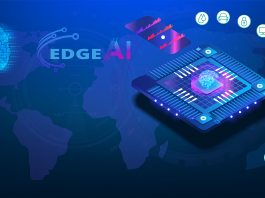Edge AI enables real-time intelligent systems at the edge with specific human-level decision-making, problem-solving, pattern recognition, and learning capabilities.
Processing data and increasing intelligence at the edge is a top strategic priority, especially for supporting the future needs of vertical applications – consisting of hardware stacked with software platforms – in compliance with the European Chips Act and European Green Deal objectives.
The potential for edge AI: Exploring its benefits and applications
Edge AI, which represents the technology convergence of the Internet of Things (IoT), edge computing, and artificial intelligence (AI), allows processing data at the edge and brings several benefits like reduced latency, bandwidth requirements, power consumption and memory footprint while increasing security and data protection. Edge AI has a key role to play in various industrial domains and needs specific hardware to be stacked up with software, AI algorithms, platforms and datasets.
Intelligence at the edge of the device allows for the processing of information locally and the response in real-time to situations and scenarios instead of communicating with a central cloud or server. Autonomous systems must respond in real-time to what’s occurring in a specific context. Decisions are time-sensitive, and latency is crucial in edge AI applications in various industrial sectors.
Edge processing redefines the interconnected device landscape. Moving data processing and analytics to the edge and employing AI techniques with embedded security enables new real-time applications that are, to some degree, free from concerns of data bandwidth and network reliability.
Rendering raw data into useful information at the edge decreases communication bandwidth and data storage requirements while increasing security and privacy and reducing energy consumption. For intelligent applications, the edge AI computing and processing concept is reflected in the emergence of different edge layers, including micro-edge, deep-edge, and meta-edge.
The Chips JU EdgeAI project
The Chips JU EdgeAI project is a key initiative for the European digital transition towards intelligent processing solutions at the edge and an implicit result of the European Chips Act initiative. The project strongly contributes to Europe having the technologies and applications to strengthen its edge AI design and development capabilities.
By enhancing AI-based electronic components and systems, edge processing platforms, AI frameworks and middleware, and methodologies (to ease, advance and tailor the design of intelligent devices at the edge), the project supports the development of edge AI vertical solutions. For the vertical industrial sectors in the digital industry, energy, agri-food and beverage, and the digital society, edge AI technologies advance the innovation in security, trust, and energy efficiency across industrial infrastructures and democratise the deployment of AI across segments of EU research development and industry.
Working within a dynamic European ecosystem
The European Chips Act strengthens Europe’s silicon competitiveness and resilience and assists in achieving both digital and green transitions. Through large-scale projects like Chips JU EdgeAI, it strongly contributes to European supply, resilience, and technological leadership in semiconductor technologies and applications.
The European Chips Act aims to jointly create a European chip ecosystem by linking the European world-class research, design, production, and testing capacities. This involves European tech sovereignty by strengthening the European research and technology leadership, reinforcing its own capacity to innovate in chip design, manufacturing, and packaging, increasing the production capacity and education, and developing solid global semiconductor supply chains. As semiconductor chips determine the performance of digital systems, they are crucial to key digital technologies (including AI, edge computing, intelligent connectivity and beyond) as set out in the EU’s 2030 Digital Decade.

In this context, the EdgeAI project has created a dynamic European ecosystem involving projects and initiatives addressing edge AI technologies and applications. These activities resulted in joint events like the European Conference on EDGE AI Technologies and Applications – EEAI 2024 held this year on 21-23 October 2024 at the Hotel Regina Margherita, Cagliari, Sardinia, Italy.
EEAI 2024 aims to provide a European forum for sharing the latest scientific research and industry results using edge AI technologies and applications. Its scope covers the edge AI technology stack following emerging research and innovation from hardware to software, edge AI frameworks, architectures, algorithms, data types and methods to various applications.
Developing innovative technology solutions
Chips JU EdgeAI project concentrates its activities on advancing AI technology development according to the AI technology stack, addressing research and innovation across the stack layers, from AI hardware, interfaces, frameworks, software, algorithms, architectures and methods, and data types to applications in different industrial sectors.
The development of AI solutions across the AI technology stack leads to the emergence of multimodal edge AI implementations that yield real-time performance at the edge for various industrial sectors, resulting in the integration of a combination of AI HW/SW building blocks in different AI-based applications, AI software algorithms across the edge continuum, AI models, compression, optimisation and hybrid and scalable architectures Systems on Chip (SoC) and Systems on Module (SoM) architectures.
The devices at the edge are currently operated with SoC/SoM to build single-board computers with very few discrete devices. Power efficiency and cost are key metrics here, and building systems with, e.g., two processors with different computational power/power efficiency characteristics might lead to very efficient AI-based solutions.
Chips JU EdgeAI project provides valuable contributions to processing at the edge, processing data either directly at its data source or offloading it to connected components. Algorithms and applications are optimised to leverage developed hybrid HW architectures complementing CPUs with specialised processing units like graphics processing units (GPUs), neural processing units (NPUs), tensor processing units (TPUs), and neuromorphic processing units to enable AI on modular chip platforms for industrial sectors including digital industry, energy, agri-food and beverage, and the digital society.
Disclaimer
This work is conducted as part of the Chips JU EdgeAI “Edge AI Technologies for Optimised Performance Embedded Processing” project, which has received funding from Chips JU under grant agreement No 101097300. The KDT JU receives support from the European Union’s Horizon Europe research and innovation program and Austria, Belgium, France, Greece, Italy, Latvia, Netherlands, and Norway.


Please note, this article will also appear in the 20th edition of our quarterly publication.








